| Please access the following URL if you want to secure using SSL. All pages in the site will be secure pages. |
https://secure02.blue.shared-server.net/www.fish-food.co.jp/message english 1.2023.html |
Welcome to FISH FOOD TIMES
Jan. 2023 issue No.229

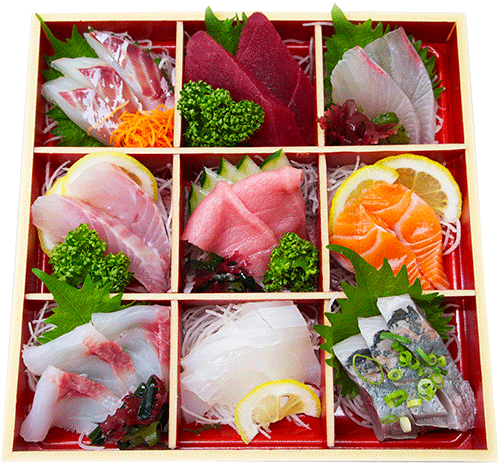
Minimum assorted sashimi
Suffering from soaring prices of imported fish, frozen fish, and farmed fish
I apologize for what happened a while ago. The author coined the term "minimum assorted sashimi" and used it for the first time exactly 30 years ago in the February issue of FISH FOOD TIMES (paper version) in 1992. The minimum assorted sashimi in this first page image was created by the author eight years ago in June 2014, not at that time. So, I think it can be said that this is relatively new (?) compared to 30 years ago. I was a little hesitant to bring such a stale image to the beginning of the January issue of the new year, but I decided to include it first because it symbolizes the theme of this month's issue.
So, I thogt that even if it's too exaggerated to describe what happened 30 years ago as "learning new from the past", it might be somewhat helpful to remember ideas from at least several decades ago in this environment and make use of them.
On December 20 (Tuesday), the Bank of Japan announced a partial review of its monetary easing policy. As a result of this, the situation of yen depreciation turned into a situation of appreciation, and although it was around 133 yen to the dollar in late December, the yen may depreciate again if the US FRB announces further interest rate hikes in the future. However, the increase in the price of marine products is not only due to the impact of the yen's depreciation, This is the result of a complex intertwining of world affairs, including the war in Ukraine. So, even if the yen were to return to a slightly stronger yen, I don't think the price of marine products would immediately lead to lower prices. For the time being, it seems better to be prepared to operate the fish market while accepting the current high purchase price of marine products.
In fact, at the end of last year, I encountered an incident that symbolically shows that the fish market manager is having a hard time securing a gross profit margin. It happened at the company I was instructing, and I was shocked. I will withhold the name of the specific company and store, but it has been 9 years since I have instructed the fisheries department of the store to improve. The president of the company and the author agreed on the direction of adding value, and as a result of steadily building up that direction without wavering, the reputation of the fish market was steadily increasing. In particular, the assortment of sushi and sashimi that utilizes raw bluefin tuna has become a great differentiating weapon as a monopoly that shows the characteristics of the store while other companies do not have the means to handle raw bluefin tuna.
However, some of the standard products that should use raw bluefin tuna, which existed as a strong weapon of the store, were switched to thawed bigeye tuna and yellowfin tuna. Not only that, when the large fatty parts of raw bluefin tuna could not be used up, they were placed in an ultra-low temperature stocker, taken out little by little, thawed, and labeled as raw bluefin tuna for commercialization.
Knowing this fact, which I do not want to hear and which should not exist, I had no choice but to say, "That's wrong, you shouldn't do it..." I was shocked.
In the previous fiscal year, the fisheries department of that store had the highest growth rate in ordinary profit in the department, and was so successful that it received the president's commendation. . Among the fisheries departments of supermarkets nationwide, there are many stores that have never posted ordinary profits, but this store has continued to make ordinary profits every year. Therefore, the fisheries department of this store must have had a higher hurdle than the previous year's ordinary income.
And the overall purchase price hike, including not only marine products but also related materials, which occurred in 2022, seems to have made it difficult to maintain the division's markup ratio and gross profit margin. To make matters worse, the number of customers decreased due to the refurbishment of a competitor's store, and it is speculated that the manager of the fisheries department was further driven into a corner and dabbled in something that should never have been done.
What happened to the fish department by doing something that deceives customers with such tricks? The sales of the stores that had been affected by the opening of a refurbished rival store were left behind by other departments while the sales of meat and fruits and vegetables returned to 100% of the previous year's sales in about three months, while only the marine products department was sluggish at 95%. . When I think about why it became such a number, it seems that I have probably caused a phenomenon of customer departure. In other words, the regular customers who are fans of the fish section of this store know well the product grade of sushi and sashimi using raw bluefin tuna, and they probably have a sense of the taste in their heads.
Repeaters who have purchased such products many times, what is this? ..., this is different from before..., I guess I felt it. There must be more than a few customers who have felt the gap between this kind of product and conventional products. The greater the gap, the greater the degree of disappointment, and it is not surprising that not a few of the customers among them will react to "I will not buy from this store again."
What I remembered was the business motto, "It takes years and decades to build credibility, but it only takes a moment to lose credibility." The series of events described above is a typical example of how deceiving customers in order to pursue short-term profits leads to greater retaliation. Even if efforts to return to the original state must be made as soon as possible, I think we have no choice but to look at the future numbers to see how long it will take for customers to show the same purchasing attitude as before.
Adapt to change
Encountering this kind of thing made me keenly aware that the price hikes that occurred in 2022 had a major impact on business. Among the stores nationwide, there are stores that can pass on the increase in the purchase price directly to the selling price, and stores that cannot raise the selling price, leading to a decrease in profit. It would not be an exaggeration to say that the competence as a merchant is now being questioned as to how to respond to such environmental changes.
I remember that it was the late Isao Nakauchi, the founder of Daiei, who said, "Retail is a business that adapts to change." From a global perspective, from the beginning of 2020, there was the novel coronavirus that threw the world into chaos, and in 2022 there was also the war in Ukraine. The world has changed so much over the past three years that it can be called a turning point in history. How should we respond to such drastic environmental changes? In 2023, in many ways, individual responses will be questioned.
In the 2022 FISH FOOD TIMES, Syunsen assorted sashimi was the theme in the July issue (No.223) and August issue (No.224). This is because the fisheries sector thought it would be an effective way to deal with the rising cost of marine products. The idea and method are described in detail there, so if possible, I would like the readers to access it and refer to it.
Another method I would like to propose is the minimum sashimi platter introduced in this month's issue. In the July issue of FISH FOOD TIMES in 2022 (No.223), we proposed "Syunsen minimum assorted sashimi" that combines these two methods, but this month's issue focuses on the idea of minimum, I would like to continue the article.
As mentioned above, the theme of minimum sashimi was taken up 30 years ago in the February 1992 issue of the paper version, so I dared to avoid using it as a theme in the web version. . However, I was inevitably involved in the big environmental change in 2022, so when I fumbled about what kind of way to escape from the predicament, I realized that there was another method called minimum assortede sashimi.
The following is a scanned image, so I think the text is not clear and hard to read.
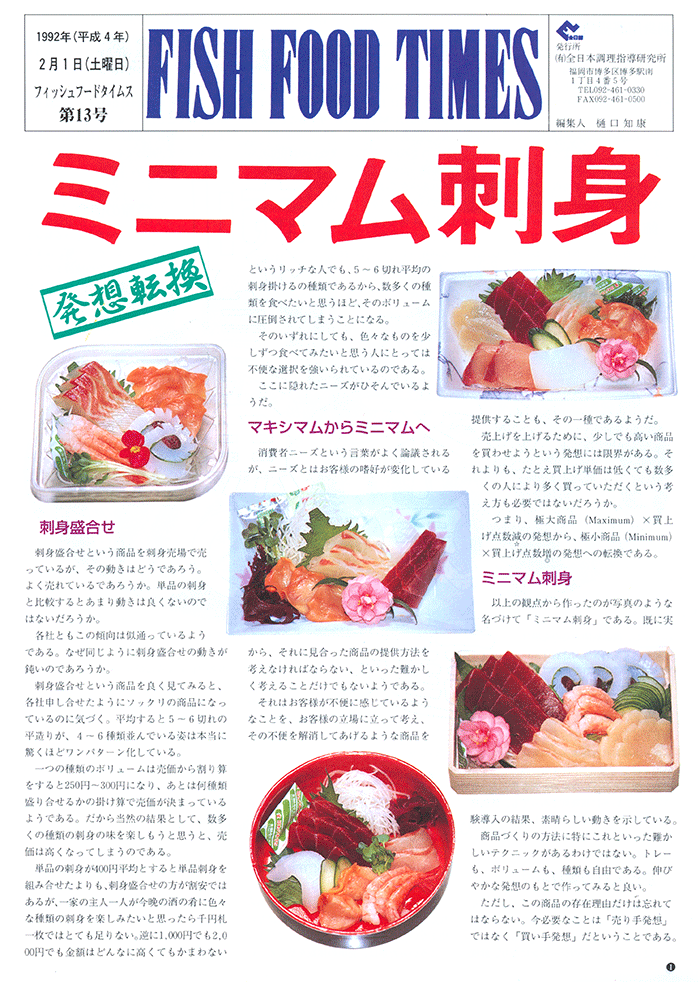
The origin of the idea of minimum assorted sashimi is to meet the needs of "I want to enjoy various sashimi little by little". However, the contents are now 30 years later, and it seems that there is something that cannot but change a little. This is because we are confronted with the difficulty of maintaining sales and securing profits from marine products whose main ingredients are imported fish, frozen fish, and farmed fish, whose prices have risen sharply since last year. In order to overcome this situation, we are forced to change our way of thinking.
For example, the image below is a minimum assorted sashimi with 10 servings of "various sashimi little by little". Let's call this item A.
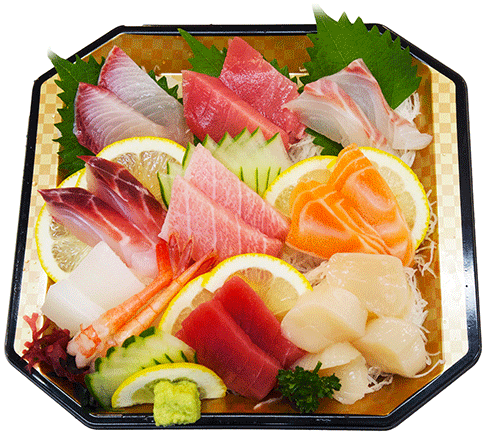
Only one of these is wild fish, but the rest are all imported fish, thawed fish, and farmed fish. This is a gorgeous assorted sashimi that uses two pieces each of large fatty, medium fatty, and red tuna farmed bluefin tuna as a central position. The purchase cost of most of the fish used in this image has increased since more than a year ago. Compared to when this work was made in August 2016, it is clear that if the same thing is made now, it will not be possible to secure a sufficient markup rate unless the selling price is raised. Even if you add the cost increase to the selling price and secure the necessary markup ratio, if the store sells without problems, I don't think you will have much trouble. However, it is common for the majority of stores across the country to have an impact on sales as soon as they raise their selling prices.
The image below was created 18 years ago in June 2004. I didn't really want to make this, but I remember that the purpose was to make a minimum assorted sashimi with a low cost and selling price. For that purpose, we used defrosted bigeye tuna for tuna, defrosted trout for salmon, imported defrosted spear squid, imported boiled octopus that was still cheap at the time, and even cheaper defrosted amaebi. The amberjack is thinly sliced hiratsukuri sashimi, the red sea bream is usutsukuri sashimi to reduce weight, and the scallops are split into three pieces. Finally, the horse mackerel uses a cheap fish called bean horse mackerel to serve half.
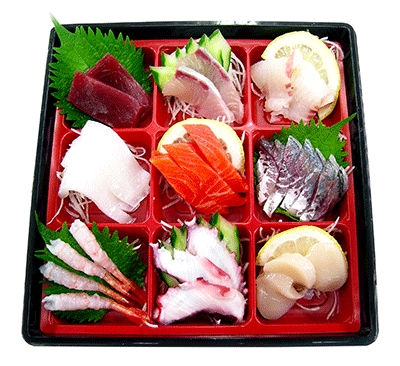
This 9-point assorted minimum assorted sashimi is clearly not attractive compared to the 9-point assorted sashimi in A above, so the image is daringly displayed in a small size. This item is B.
And next is the 9-point minimum assorted sashimi in the opening image. I would like to classify this product in the image below as C.

If you explain the contents of this C in order from the upper left to the right, the natural sea bream that becomes cheaper from spring to early summer. Next was wild bluefin tuna juvenile red meat, then hirago, a juvenile wild hirasu. From the left end of the second row, stonefish, wild bluefin tuna juvenile meatmedium fatty, raw atlan salmon. The third row from the left is so-iuy mullet, then a quarter of the spear squid, and finally the middle horse mackerel. Basically, only raw salmon is not available in the wild, and when wild bluefin tuna juvenile is not available, replace it with meat medium fatty of wild bigeye tuna. Ultimately, there is also the option of farmed bluefin tuna medium fatty tuna, but as a direction, we are devising how to increase the amount of wild fish.
Compare the three images A, B, and C above. I would like you to apply the current purchase cost of your own store, derive the selling price based on the necessary markup ratio, and simulate which product is likely to sell the most and make a profit as a result. However, since natural fish are market prices, there is no choice but to apply them based on experience. In the 2022 FISH FOOD TIMES July issue (No.223) and August issue (No.224), I used a table to write an article about sashimi costing. But this time, I would like to encourage readers to use a similar format from that time and do their own calculations. I would like you to make a calculation and guess which of A, B, and C is likely to sell as a total balance.
The key is to review domestic fresh fish
What would be the result of comparing A, B, and C? If A secures the necessary markup ratio, the selling price will probably be the highest and it will be difficult to sell. And although the selling price of B may be lower than that of A, I feel that I am reluctant to aggressively sell it in terms of content. After all, it is C that the author wants to focus on. With this C, I feel that I can do various interesting things with just one method, and I think that there must be such a possibility.
However, it seems that what is likely to come out as a counterargument is a remark to the gist of "Where do such cheap wild fish come from, and where exactly are they?" It is true that in the fish departments commonly seen in ordinary supermarkets, the presence of wild fish has faded away, and it is normal for products using imported, frozen, and farmed fish to stand out. . This is probably because the fisheries departments of the supermarkets, which used to sell fish, consciously changed their operating methods to this form. As this trend strengthens, the percentage of in-store sales in the fisheries sector continues to decline, and now the sales in the prepared foods sector have overtaken the sales, and the national average is less than 9%, which is a pity.
Restaurant companies such as izakaya chains and sushi-go-round sushi chains across the country are focusing on handling wild-caught fish, as if to take advantage of the gaps in the fisherlies departments of supermarkets, which no longer put effort into handling wild-caught fish. Even now, I feel an extraordinary amount of effort being put into that direction, Regarding the handling of natural raw fish, I feel that the fisherlies department of supermarkets has taken away stock.
From the point of view of a professional like myself, this situation is truly pathetic and frustrating. If this reality is left as it is, it is expected that the fisheries department will be relegated from the important position of the fresh food department, and its presence will gradually diminish, and I cannot help but feel a sense of crisis. However, there is also the question of how many people in the supermarket industry have a sense of crisis like the author. If the seafood department of supermarkets will continue to decline in sales and profits this year, not just in 2022, supermarket managers will become impatient, saying, "From now on, there will be no need for a separate fish sales floor." And I just hope that it will not go to such an extreme theory.
Based on my experience so far, I can say without a doubt that "Fish sales floors that are good at handling domestic fresh fish are highly evaluated by customers and are doing well". At one company that I am associated with, there is a fish department that boasts that "there is nothing to be afraid of, no matter how high the purchase price of fresh fish comes in." The reason why I can say that is because the fish department sells sashimi and sushi very well. The store's sashimi and sushi are commercialized with fresh fish procured with a positive attitude. As a result, the contents of the products change every day, creating a system that sells attractive sashimi and sushi that keep customers from getting bored.
On the contrary, supermarkets with fisheries departments, which continue to reduce the sales composition ratio of their stores, have lost their presence due to lack of fresh fish stocks. Sashimi and sushi are all standard products that use only cultured fish and thawed fish, and the same lineup every day, so customer evaluations are low and sales do not increase. In other words, if the company wants to improve the sales of the fisherlies department, it will find the key to breakthrough in performance by reviewing the handling of domestic fresh fish.
If the managers and sales managers of supermarkets are satisfied with the direction, they must re-strengthen their ties with fishing ports in production areas and fisheries officials nationwide, strengthen the purchase of fresh fish, and change the fish sales floor. . But there are some things you should never do. This is one of the misunderstandings of product managers and fishery buyers, and is a top-down trading posture of procuring fish. Now, in this kind of environment, in a sense, it may be more correct to ask "Please let me purchase". This is because the current coastal fishery industry is aging, and there is a shortage of human resources to replace generations. In other words, even if you tell them you want this much fresh fish, they won't necessarily give you the amount you need.
One of the underlying reasons for the decline of coastal fisheries is that the fish departments of supermarkets have avoided fresh fish and put more emphasis on the sale of foreign-produced fish, such as imported and frozen fish. Coastal fishery is an industry that has historically supported the foundation of Japanese food culture, which is characterized by fish-eating culture. In order to maintain the Japaneseness, we must never let it decline. I would like them to be aware that the fisheries department of the supermarket is one of them, and I would like them to show the necessary actions to do so.
Let's cooperate in restoring productivity of coastal fisheries
As mentioned above, the handling of domestic fresh fish is the key to revitalizing the fish departments of supermarkets, which continue to decline, and regaining their appeal. It is also important to restore the coastal fisheries in order to handle the domestic fresh fish abundantly.
The Ministry of Agriculture, Forestry and Fisheries has announced that the actual situation of fishery production in Japan is as shown in the figure below.
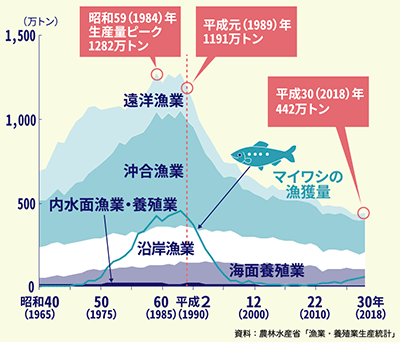
Looking at this graph, while the production of deep-sea fisheries and offshore fisheries has decreased dramatically, it seems that there has been no major change in coastal fisheries, but it can be seen that the production itself is gradually decreasing year by year. Changes in the marine environment are thought to be a major factor behind the decrease in coastal fisheries production. Specifically, there is a decrease in seaweed beds due to sea desertification, a decrease in aquatic products due to coastal development, and a decrease in areas suitable for raising fry.
Among these factors, I would like to mention in particular the reduction of seaweed beds. During Japan's high-growth period, coastal areas were actively developed, and as a result, seaweed beds decreased significantly. The main causes are land reclamation along the coast, the deterioration of seawater transparency due to industrial wastewater, and the influx of chemical substances. In the Seto Inland Sea, eelgrass beds, one of the seaweed beds, have decreased by 70% over the past 30 years. Seaweed beds support the lives of many aquatic organisms, and in addition to providing a place for spawning and young larvae to grow, decompose organic matter in the water, absorb nutrients and carbon dioxide, and supply oxygen. It plays an important role in purifying seawater. Without seaweed beds, which are sea forests that surround the land, we would not be able to enjoy the benefits of abundant marine resources.
The seagrass beds are divided into eelgrass beds, arame/kajime beds, garamo beds, and kelp beds, and various types of seagrass beds exist three-dimensionally in coastal areas depending on the sea area, water depth, and bottom sediment. However, there is a big problem all over the country, which is a phenomenon called "isoyake", which destroys the balance of the ecosystem and causes the seaweed beds to disappear due to the overpopulation of mottled spinefoot, brassy chub, and sea urchins that eat the seaweed in the seaweed beds. In particular, sea desertification caused by feeding damage by sea urchins is one of the major causes of the decline in coastal fisheries production.
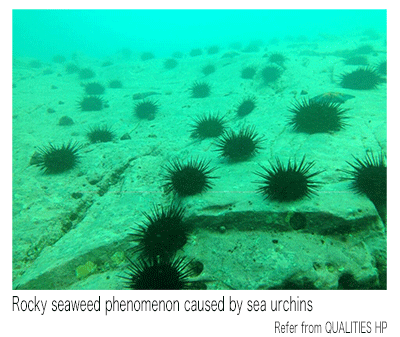
However, an epoch-making countermeasure against feeding damage by sea urchins, which is one of the causes of this isoyake, has been devised, and it seems that this is getting on track as a business. In 2017, Masahide Kuribayashi, the representative of Oita Uni Farm Co., Ltd., learned about Uninomics, a company that has the know-how to raise sea urchins that cause rocky seaweed. In 2019, he established Oita Uni Farm Co., Ltd. with Uninomics as a partner. After that, the purple sea urchins that had devoured the seaweed beds were raised on land for 10 weeks with a unique diet rich in umami, which uses scraps of edible kelp. As a result, the purple sea urchin was successfully grown into a delicious sea urchin that looks just like red sea urchin, and the world's first sea urchin farming business was started.
Based on its success, Maruyama Suisan, a seafood processing company in Nagato City, Yamaguchi Prefecture, collaborated with the same Uninomics to create the world's largest closed circulation land-based aquaculture system. And using this, it is said that a full-scale sea urchin farming business will start from November 2022. In addition to this, from around 2018 there is a sea urchin named cabbage sea urchin produced in a joint project between Yokohama Maruo and the Kanagawa Fisheries Technology Center, which raised sea urchin using cabbage before it was discarded. In addition, Odawara Fisheries Cooperative, Aomori Prefecture, Miyagi Prefecture, Hiroshima Prefecture, etc. seem to have started similar efforts.
The author is watching these efforts and commercialization with great interest. Of course, it is the biggest attraction that it is effective against sea desertification. However, not only that, but it can also be evaluated as a feat of killing two birds with one stone when domestically produced sea urchin, a high-grade marine product, is available raw and delicious.
The domestic production of sea urchin is around 7,000 tons nationwide, and the import volume is around 10,000 tons. Raw sea urchin is very expensive, and relatively cheap imported sea urchin is treated with alum, which has a unique smell, astringency and bitterness and is very unpleasant. I'm sure I'm not the only one who would be happy if the sea urchin farming business gets on track and people can get "delicious and reasonably priced domestically produced sea urchin." Those involved in the fishery industry must sincerely wish for the same thing.
It goes without saying that we welcome the expansion of domestic sea urchin production in this way. However, the author is more interested in the fact that this project will get on track and reduce predation damage by sea urchins, which is the cause of isoyake. Also, seaweed beds, which are the habitats of coastal fish, will revive like forests all over Japan, and it will be an opportunity for coastal fisheries to revive as they did in the past.
Well, it's about time for this month's issue to wrap up. As mentioned above, in order for the fish market to show its presence again, the author believes that "it is important to have an abundance of domestically produced fresh raw fish". The key to this is the "reconstruction of coastal fisheries'', the people involved in the business of selling marine products, must do what we can to help.
The author believes that the relationship between producers and sellers, sellers and buyers should not be narrow-minded and competing for profits, but that we should work together to protect Japan's fish-eating culture. Finally, I would like to conclude this month's issue with the words "three-way good", which is the essence of Omi merchants' business.
Three-way good is "good for the seller, good for the buyer, good for the world"
| Please access the following URL if you want to secure using SSL. All pages in the site will be secure pages. |
https://secure02.blue.shared-server.net/www.fish-food.co.jp/message english 1.2023.html |
An opinion and the communication are to iinfo@fish food times
Date of updating 1 Jan. 2023
